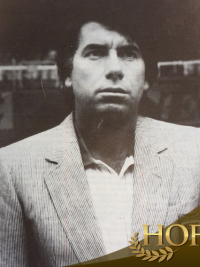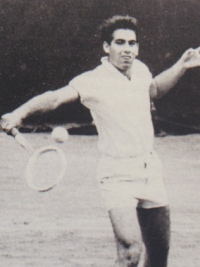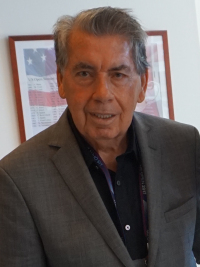Manuel Santana
Full name: Manuel Martinez Santana
Nickname: Manolo, Supermanuel
Nickname: Manolo, Supermanuel
| Born |
Subscribe now
This information and data is not available because you are not our subscriber yet.
Please click here and get full access to the entire database! |
|---|---|
| Died | |
| Class of HOF | |
| Plays | |
| Bio | He also known as Manolo Santana, was a Spanish tennis player. He was ranked as amateur world No. 1 in 1965 by Ned Potter and in 1966 by Lance Tingay. Santana was born in Madrid, and began his career as a ball boy and "picked up" the game. Santana took up tennis by chance after bringing a meal to his brother who worked in a tennis club in Madrid. "I saw men in pants playing tennis. I was immediately charmed. I started as a ball boy and then I started playing. In the end, I am an example of humility in an elitist world," he told newspaper El Espanol. In 1965, Santana led Spain to unexpected victory over the U.S. in the Davis Cup, and he became a national hero. Despite his previous Grand Slam successes in the French Championships (1961, 1964) and the U.S. Championships (1965), Santana's win at the 1966 Wimbledon lawn tennis championships was a surprise, where he defeated the sixth seed Dennis Ralston 6–4, 11–9, 6–4. He also managed to attain the world number 1 ranking in 1965. His last big tournament win was in 1970 by winning Barcelona where he defeated Rod Laver 6–4, 6–3, 6–4. He also captured the doubles title in Barcelona that year when he teamed with Lew Hoad to defeat Laver/Andrés Gimeno 6–4 9–7 7–5. Santana was named to the International Tennis Hall of Fame in 1984. At the 1968 Olympic Games in Mexico City, Santana won the gold medal in singles, but tennis was only a demonstration sport at that time. It became a medal sport in 1988 (after another demonstration event in 1984). Santana later was captain of the Spanish Davis cup team twice, once in the 1980s and again for four and a half years in the mid-1990s until he was dismissed in 1999. Until 2019, he was the organizer of the Madrid Masters. Santana managed the Manolo Santana Racquets Club, a tennis club in Marbella, Spain and the Sport Center Manolo Santana, in Madrid. Santana and Lleyton Hewitt are the only Wimbledon men's singles champions to lose in the first round in the following year; Hewitt's loss was to Ivo Karlovic in 2003 during the Open era, while Santana's was to fellow latino from Puerto Rico and U.S. No.1 Charlie Pasarell in 1967 in the the last year before the Open era. Santana appeared at the 2011 Wimbledon Championships in London in the Royal Box to watch the men's final which was between his fellow countryman Rafael Nadal and Novak Djokovic (who had become world No. 1 after winning his semifinal match against Jo-Wilfried Tsonga). In 2020, Santana was awarded the ITF Philippe Chatrier Award for his contribution to tennis both on and off the court. Santana died on December 11, 2021, at the age of 83. The Madrid Open announced his death but not the cause. "One of the masters of legerdemain, Manuel Martinez ‘Manolo’ Santana was the first post-World War II European to gain universal respect because of his ease not only on Continental clay, but the way he took to grass. As well as his winning the most difficult clay event, the French singles in 1961 and 1964, both over Nicola Pietrangeli, he also captured the greensward gems, Wimbledon of 1966 and the U.S. Championship of 1965 at Forest Hills. In doing so, the engaging Spaniard was the first European champ at Forest Hills since Frenchman Henri Cochet in 1928. “He was a magician on clay,” says Rod Laver. “Manolo could hit the most incredible angles, drive you crazy with topspin lobs or drop shots. And he improved his volleying so that he was dangerous on grass, too. He toyed with me a couple of times in Europe, letting me know I had a lot to learn about clay.” In 1965 Santana became a national hero in Spain and was decorated by the country’s leader, Francisco Franco, with the coveted Medal of Isabella, qualifying for the title Ilustrissimo. That year Santana spearheaded the 4-1 upset of the U.S. at Barcelona during the Davis Cup campaign and led Spain all the way to the finale for the first time. Although the Spaniards were turned back in Australia, 4-1, Santana gave Roy Emerson his only defeat in 12 title-round singles. Two years later he drove Spain to the finale again, salvaging the only point in a 4-1defeat by beating John Newcombe. Only Pietrangeli (164 singles and doubles in 46 series) and Romanian Ilie Nastase played more Davis Cup than Santana. Manolo worked 120 singles (69-17) and doubles (23-11) in 46 series between 1958 and 1973. He set Cup records by winning 13 singles matches in 1967 (equalled by Nastase in 1971), and also by winning 17 singles and doubles in 1965 and 1967 (topped by Nastase’s 18 in 1971). Born May 10, 1938, in Madrid, he worked as a ball boy at a local club and picked up the game. He was very appealing, a slender 5-foot-11 right-hander, who frequently flashed his warm, toothy smile at play and was an admirable sportsman. His racket control was phenomenal, enabling him to hit with touch and power. He had great flair, the ability to improvise and to inspire himself and his partners and teammates. Never losing heart in the doubles of the 1965 Davis Cup against the U.S., he rallied partner Luis Arilla as they stormed back to beat Dennis Ralston and Clark Graebner, 4-6, 3-6, 6-3, 6-4, 11-9, in an emotional battle that clinched the decision. Cushions showered down on the two Spaniards as they were carried about the stadium court of the Real Club de Tenis in the manner of bullfighters. Santana and Arilla wept with joy at the most tremendous victory in Spanish tennis annals. Manolo had given the home side a 2-0 lead by beating Frank Froehling, after Juan Gisbert upset Ralston. Less than a month later a similarly jubilant celebration was staged at Forest Hills after Santana jolted Cliff Drysdale in the U.S. final. A troupe of dancers from the World’s Fair’s Spanish Pavilion toted him from stadium to clubhouse, whereupon they serenaded him. The following year was Santana’s at Wimbledon, where he beat Ralston in the final and enthralled the gallery with his point and counterpoint thrusts. But 12 months later, beaten by Charlie Pasarell, he made an historic footnote as the lone top-seeded defending champion to lose in Wimbledon’s first round. Beginning in 1961, Santana was in the World Top Ten seven years, No. 1 in 1966. His career was virtually over when the Open Era arrived, but he did elate his countrymen by winning Barcelona in 1970, his last singles victory, plus three pro doubles titles. Overall as amateur and pro he won 72 singles titles. Santana came out of retirement briefly in 1973 to play his last season of Davis Cup, and again in 1974 to act as player-coach for New York in the new World Team Tennis League. He was named the second Spaniard to the Hall of Fame, following Manuel Alonso, 1977. His successes spurred the rapid development of tennis in Spain, where the sport was not much noticed prior to 1965, but is booming today. His protégé was Manuel Orantes, called Manolito (Little Manolo), who won the U.S. Championship at Forest Hills a decade after his own, beating Jimmy Connors though the surface had by then been transformed to clay. He spent time as Spain’s Davis Cup captain, and has long been a friend to aspiring young players. But despite Spain’s important current standing in tennis today, none of its fine players has yet measured up to his four major singles. Call him the Godfather of the Groundstrokes." - Source:Bud Collins |
| Misc | Subscribe now |
| Tournament | AO | RG | W | US | Win-Loss |
|---|---|---|---|---|---|
|
Subscribe now
This information and data is not available because you are not our subscriber yet.
Please click here and get full access to the entire database! |
|||||


